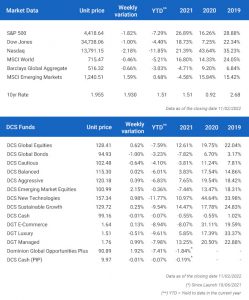Inflation comes in hotter than expected
The major news last week was the release of US Consumer Price Inflation (CPI) data for January. The reading, which analysts thought would come in at 7.3%, hit a 40-year high and was ahead of expectations at 7.5%, year-on-year (YoY). This was 0.2% higher than expected, and the steepest 12-month rise since 1982. Core CPI (which removes energy and food costs) came in at 6% YoY, 0.1% higher than estimated.
While higher inflation is a complex topic, most investors are focused on how it will impact the Federal Reserve (Fed)’s monetary policy, and this is what caused equity markets to decline in the back-end of last week.
Expectations are now rising for a bigger hike in interest rates in March in response to hotter inflation (higher rates in theory cool inflation).
In the medium-term, tightening monetary policy is, ultimately, a positive for the US (and global) economy. Monetary conditions have been too loose for too long. But in the short-term, higher inflation prints and likely monetary tightening in response will continue to generate bouts of market volatility. The question on every investor’s lips is: how do we navigate this period of higher volatility?
To reiterate our message from last week, the answer is: stock picking.
Higher inflation and less monetary stimulus will hurt valuations of some stocks, especially those with ‘sky high’ valuations based on extraordinary predictions of future success (think: Tesla, Zoom, Peloton, et al.). These stocks and others like them have already sold off heavily and should be avoided. Meanwhile there is a growing list of very high quality stocks trading at reasonable valuations. These should perform relatively well during bouts of inflation and volatility.
Valuation and stock picking is the only game in town, we would argue. Passive investing via ETFs in market indexes will only translate to market volatility being replicated in your own portfolio. With inflation in the US now at 40-year highs, that does not sound like a good idea to us.
‘Buy low, sell high’ may sound like a cliché, but most fund managers and investors have been doing the opposite over the past decade, buying expensive ‘hype’ assets (bitcoin, etc.) after the price has gone up, in other words they have been employing a strategy of: ‘buy high, sell low’.
That sounds like a really bad idea, and it is already costing investors exposed to those strategies.
These market conditions are where active investment strategies thrive relative to all others, and at Dominion, we have in 2022 already been taking advantage of volatile markets to reduce risk exposures at (or close to) market highs and increase exposures to beaten down, high quality stocks, at (or close to) market lows… and we’ll keep on doing this so long as markets remain volatile.

Fuentes: Bloomberg, Yahoo Finance, Marketwatch, MSCI







